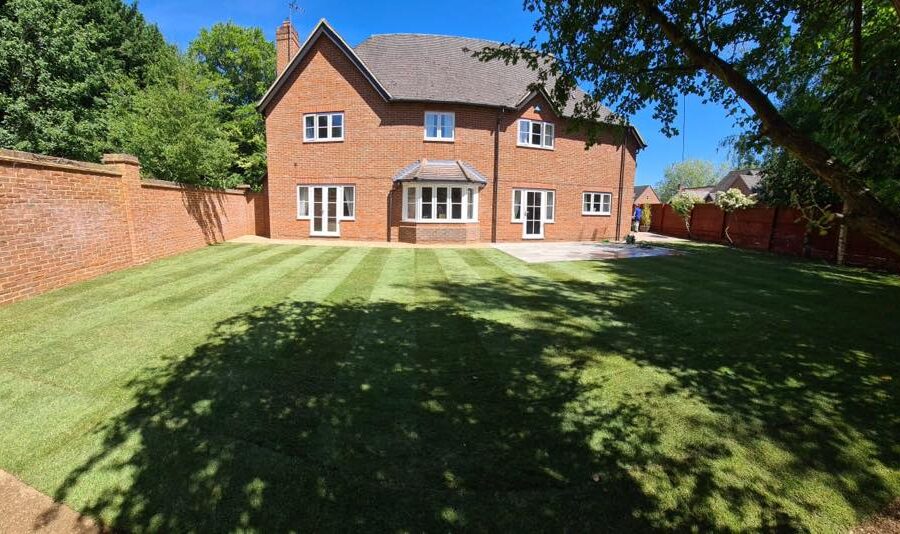The most common questions we get asked relating to turfing and artificial grass.
Common Turfing & Garden Questions
We are always being asked questions about our work, and how to best look after a freshly laid lawn, or the best ways to maintain your garden.
At Bolton Turf and Landscapes Ltd, our professionals have the experience and skills to assist you in maintaining your garden so it always looks at it’s best all year round. To help you look after your garden when our work is done, we have compiled a list of the most commonly asked questions below.
We are always on hand to assist, so if you have any further questions, please do get it touch.

Turfing Questions
How do you prepare the ground for laying turf?
- Clear away any plants, weeds and debris.
- Dig or rotovate soil to a depth of at least 15cm.
- Improve soil texture or quality if necessary.
- Level the area.
- Firm the soil.
- Add pre-turfing fertiliser.
- Rake and level again.
- Lay your turf.
When is it best to lay new turf?
Turf can be laid any time of year except on frozen ground.
Ideal times to lay turf are in early-mid autumn and early spring, when the ground is relatively warm – which will promote new root growth.
How long after laying turf can I walk on it?
The most important things you can do to newly laid turf are to keep it regularly watered, avoid walking on the turf for at least three weeks, and allow the turf to bed in for a few more weeks before mowing it.
Should I water new turf immediately?
It is important to water your turf as soon as it is laid, to help the grass recover from being rolled and ensure that the roots bed into the soil. As the new root system develops, the watering needs of the grass will change.
What time of the day should I water turf?
Watering in the morning is the best time. It’s cooler, and winds tend to be gentler so water can soak into the soil and be absorbed by the grass roots before it can evaporate.
Artificial Grass Questions
What type of artificial grass is suitable for my needs?
Longer grasses, around 30mm mark, will give a lush, luxurious look, whereas shorter, 16-27mm products will look neater, and make for great artificial grass for dogs, pets, or kids.
Good quality artificial grass should be weighty, with a weight of 2-3kg per metre square.
How long does artificial grass last for?
With average use and maintenance, you can expect to enjoy your synthetic grass for at least 20 years, a worthwhile investment that essentially pays for itself in half that time.
As with most landscaping projects, though, the more care you give to your artificial lawn, the longer its lifespan will be.
Can weeds grow through artificial grass?
Although artificial grass has a higher resistance to weeds than natural turf, it’s still possible for weeds to grow around the edges or infrequently through small holes in the backing. Weeds can also grow through the infill, depending on the type of infill that has been used during the installation.
That is why we take extra care when laying your grass – you keep the neat and tidy look for much longer, saving you years of additional maintenance.
Can my garden flood if I have artificial turf?
Not with our premium quality artificial grass. All of our modern turf is completely water permeable. This means that the turf’s intuitive design allows rainwater to flow down the blades and seep through holes located under the turf. Teams with natural grass may see potholes develop after heavy rainstorms.
Why do you sprinkle sand on artificial grass?
The sand provides stability and protects the turf. As a result, no wrinkles or folds develop throughout it’s use. The sand also surrounds the long blades of artificial grass and ensures that they remain upright.

Easier Garden Maintenance
Whether you have a clear vision in mind or don’t know where to start, we use our years of experience and work with you to come up with a design and layout of your garden that will work with your space and budget.
Considerations to take into account include the size of your space, how you wish to use your garden and how much maintenance you are able to commit to.
Questions About Driveway & Patio Cleaning
WHATS THE PROCESS FOR CLEANING A DRIVEWAY OR PATIO?
- Use a garden hose to wet the entire concrete surface.
- Add concrete cleaner.
- Start the pressure washer.
- Apply concrete cleaner evenly.
- Flush the pressure washer.
- Wash with a pressure spray tip and water.
WHAT BAR PRESSURE WASHER SHOULD I USE?
The higher the better. We use specialist jet pressure washers that generate 250 bars of pressure. That is three times the pressure generated by your average jet washer.
Our equipment will generate a much better result than any jet washer you buy off the shelf.
WHAT ARE THE BEST CHEMICALS TO CLEAN CONCRETE?
The best cleaner for old, concrete is sodium hypochlorite at around 15% concentration. Often found in commercial and professional cleaning products, sodium hypochlorite is a type of bleach that will dissolve lichen, algae and similar growths on hard surfaces.
SHOULD I BLEACH MY DRIVEWAY BEFORE PRESSURE WASHING?
To maintain the lighter color of a concrete driveway, many people use bleach.
You should not power wash with bleach because it can damage your pressure washer.
HOW TO I REMOVE STUBBORN STAINS FROM MY DRIVEWAY?
Mix some baking soda and water together to form a paste. Spread the paste over the old stain. Let it sit for 30 minutes and then scrub the stain hard with your stiff brush or broom. If you don’t have baking soda to hand, try using washing powder instead.
Questions About Fencing & Joinery
WHAT IS THE STRONGEST TYPE OF FENCING?
If durability is a priority for your fence, take a look at DuraPost. Made from galvanised steel, it can withstand winds of up to 110mph and comes with a 25-year guarantee.
HOW FAR APART SHOULD SLATS BE ON A FENCE?
When building a fence, the fence boards are either butted tightly together, or spaced 3/8 to 1/4 inch apart to allow the wood to expand and contract in wet and dry weather.
WHAT IS THE MAXIMUM HEIGHT A FENCE CAN BE?
The legal maximum is 6ft 6 inches or 2 metres. For your front garden fence, authorities will allow you up to 4ft of fencing, meaning it will be 2ft lower than the fence height at the back of the house.
WHAT'S THE MOST HARD WEARING DECKING?
Some of the best hardwood varieties for decking are:
Oak: Very popular decking wood, with good strength and moisture resistance.
Teak: Really durable wood that offers good protection from rot and insect attack.
WHAT IS THE BEST DECKING MATERIAL?
Natural Softwood Timber Decking
Pine is the most popular timber due to its strength, availability, and pores that allow strong chemical solutions to penetrate. This gives the ideal decking material that has all the qualities of traditional timber, but is immune to fungi and rot for many years.
Beautiful Garden Landscaping
Whether you want the complete turfing service or desire a redesign of your outdoor space, we can help. From patios to decking, driveways, fencing and gutter cleaning, your project will be completed by a team of professional landscapers committed to providing an excellent service from start to finish.
Drawing upon decades of experience, industry-leading knowledge and cutting-edge technology, we create beautiful outdoor spaces that add value to homes and businesses.

Questions About Grass Seeding
CAN YOU PUT GRASS SEED DOWN AT ANY TIME?
Although you can sow grass seeds at any time of the year, it is best to sow in spring or autumn where possible. In the autumn you can expect fewer problems with weeds and the rain will make it easier to keep the seedbed moist and the soil temperature will still be high.
HOW LONG DO GRASS SEEDS NEED TO GERMINATE?
Grass seed germinates at different rates, depending on various factors such as the grass species, weather, time of year and soil moisture. Typically, germination takes 5 – 10 days.
Once germinated, the grass will continue to grow at a rate of about 2 – 3cm per week.
CAN YOU OVERSEED GRASS?
Don’t overdo it or cut corners. Too much grass seed causes undue competition for resources such as light, water and nutrients, and grass seedlings struggle as a result. Too little seed leaves lawns thin or bare.
DOES GRASS SEED NEED TO BE BURIED?
Once you finish spreading the seed, use a rake to lightly work it into the soil at a depth of about 1/4 inch. Don’t bury the seeds any deeper.
Grass seed needs adequate light to germinate quickly. After raking, pass over the area with a roller, which helps ensure the good seed-to-soil contact your new seed needs.
CAN I JUST THOW DOWN GRASS SEED ON A NEW LAWN?
When seeding new lawns, it’s generally recommended that a thin layer of mulch be scattered on top. This helps hold in moisture and keep the seeds from drying out.
On older lawns, this is not necessary as the existing grass helps hold in moisture.
Questions About Garden Landscaping
WHAT IS THE MOST IMPORTANT ASPECT WHEN DESIGNING A GARDEN?
Sunlight is an incredibly important feature in any garden. The amount and quality of the light affects what kind of plants are the best fit for your garden.
Some plants need full sun, which means six hours of direct sunlight or more per day, while other plants only need partial sunshine.
WHATS THE BIGGEST MISTAKE PEOPLE MAKE WHEN DESIGNING A GARDEN?
Designing without a defined palette and choosing plants and features in various colors with no cohesive plan is a big mistake.
You could end up with either too many colours or just too much colour, which will take away from your overall design. Or you could end up with a monochromatic look with no pops of colour anywhere, leaving the garden featureless.
WHAT'S THE BEST TIME OF YEAR TO BUILD A NEW GARDEN?
The best time to begin landscaping and planting trees, shrubs, and perennials is in the months of April and May. These spring months will give your plants the opportunity to grow and acclimate during the summer and autumn.
If you are looking at a different time of the year, the next best time to begin landscaping is during the autumn months.
WHAT STAGES ARE INVOLVED IN LANDSCAPE DESIGN?
Step 1 – Consultation.
Step 2 – Planning & Design.
Step 3 – Final Design & Estimating.
Step 4 – Construction.
Step 5 – Project wrap up.
Step 6 – Maintenance.
HOW OFTEN SHOULD I REDESIGN MY GARDEN?
For most plants, and any joinery, you’re looking at 10–25 years depending on the wood type used and shrub family. After that time frame, you should revisit the overall design and look of your landscape. Proper maintenance can dramatically increase your garden lifespan.


